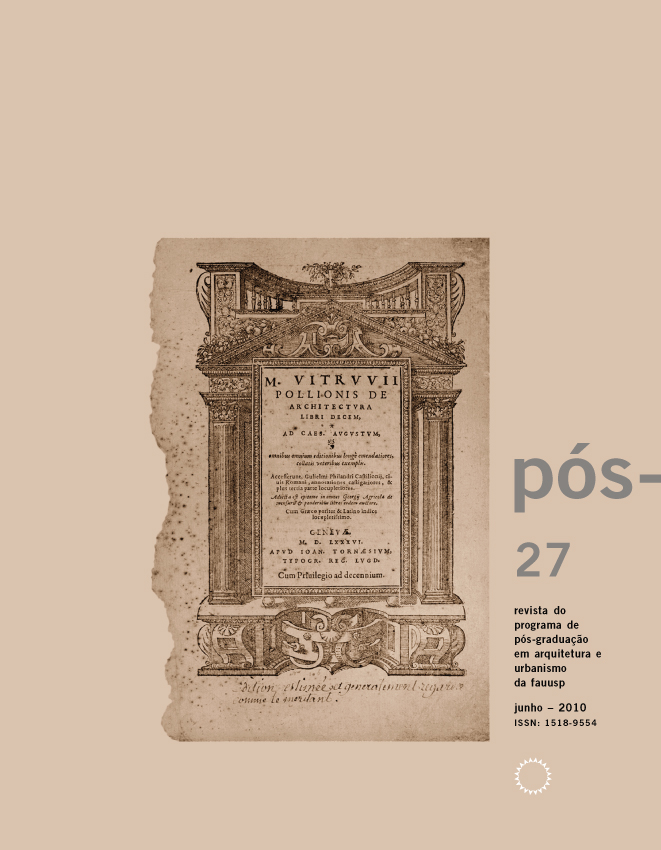Nada vem do nada: por uma revisão contemporânea do conceito de tipo edilício
DOI:
https://doi.org/10.11606/issn.2317-2762.v0i27p102-120Palavras-chave:
Tipo edilício, tipologia, morfologia, espaço, sociedadeResumo
O artigo discute o conceito de tipo edilício nos estudos do ambiente construído. O objetivo é identificar qual o sentido original do termo e como ele pode ser revisto hoje, à luz de investigações recentes. Argumenta-se que o conceito de tipo - impresso por Quatremère de Quincy em 1825 - apresenta maior complexidade teórico-conceitual do que lhe atribuem os autores italianos de morfologia do século 20 e, em essência, é um conceito que guarda mais proximidade com uma interpretação social do espaço. Por fim, o artigo propõe que o termo seja lido dentro de uma perspectiva contemporânea, a ir além do de mero método projetivo ou do modelo descritivo: compreendendo as idéias subjacentes ao conceito de tipo como contribuição para um conhecimento científico sobre o ambiente construído.Downloads
Referências
ARGAN, G. C. Projeto e destino. São Paulo: Ática, 2000.
ARGAN, G. C. História da arte como história da cidade. São Paulo: Martins Fontes, 2005.
BENEVOLO, L. A história da ciddea. São Paulo: Editora Perspectiva, 1998.
CANIGGIA, G.; MAFFEI, G. Il Lettura dell’edilizia di base. Composizione architettonica e tipologia edilizia. Veneza: Marsilio, v. 1, 1979.
CATALDI, G.; MAFFEI, G. L.; VACCARO, P. Saverio Muratori and the Italian school of plannig typology. Urban morphology. Birmingham: ISUF, v. 1, n. 6, p. 3-14, 2002.
CENIQUEL, M. A prática arquitetônica como forma de elaboração de uma crítica arquitetônica: O estudo operacional de uma metateoria. 1990. Dissertação (Mestrado em Estruturas Ambientais Urbanas) – Faculdade de Arquitetura e Urbanismo, Universidade de São Paulo, São Paulo, 1990.
COLQUHOUN, A. Typology and design method. In: JENCKS, Charles; BAIRD, George (EE.). Meaning in architecture. Londres: Barrie e Jenkins, 1970.
CURL, J. S. Classical architecture: An introduction to its vocabulary and essentials, with a selected glossary of terms. Nova York/Londres: W. W. Norton e Company, 2003.
DURAND, J.-N.-L. Précis of the lectures on architecture. Los Angeles: Texts e Documents – The Getty Research Institute Publications Program, 2000.
FORTY, A. Words and buildings: A vocabulary of modern architecture. Nova York: Thames and Hudson, 2000.
FOUCAULT, M. Microfísica do poder. São Paulo: Graal, 2006.
FRAMPTON, K. História crítica da arquitetura moderna. São Paulo: Martins Fontes, 2000.
GIDDENS, A. A constituição da sociedade. São Paulo: Martins Fontes, 2003.
HILLIER, B. Space is the machine: A configurational theory of architecture. Cambridge: Cambridge . University Press, 1996.
HILLIER, B.; HANSON, J. The social logic of space. Cambridge: Cambridge University Press, 1984.
HILLIER, B.; PENN, A. Visible colleges: Structure and randomness in the place of discovery, 1991.
HOLANDA, F. de. Espaço de exceção. Brasília: Editora Universidade de Brasília, 2002.
LAVIN, S. Quatremère de Quincy and the invention of a modern language of architecture. Cambridge; Londres: The MIT Press, 1992.
MARKUS, T. Buildings as classifying devices. Environment and Planning B: Planning and Design, Londres: Pion, n. 14, p. 467-484, 1987.
MARKUS, T. A. Buildings and power: Freedom e control in the origin of modern building types. Londres: Routledge, 1993.
MARKUS, T.; CAMERON, D. The words between the spaces – Buildings and language. Londres/Nova York: Routledge, 2002. (Architext Series).
MARZOT, N. The study of urban form in Italy. Urban Morphology, Birmingham: ISUF, v. 2, n. 6, p. 59-72, 2002.
MONTANER, J. M. A modernidade superada: Arquitetura, arte e pensamento do século XX. Barcelona: Gustavo Gilli, 2001.
MOUDON, A. V. Urban morphology as an emerging interdisciplinary field. Urban morphology. Birmingham: ISUF, n. 1, p. 3-10, 1997.
MURATORI, S. Studi per una operante storia urbana di Venezia. Roma: Istituto poligrafico dello Stato/Libreria dello Stato, 1960.
PEVSNER, N. A history of building types. Princeton: Thames and Hudson, 1997.
QUATREMÈRE DE QUINCY, A. C. Type. In: Dictionnaire historique d’architecture. Paris: Librairie d’Adrien Le Clère et C.ie, tomo II, 1832.
ROSSI, A. A arquitetura da cidade. São Paulo: Martins Fontes, 2001. RYKWERT, J. A casa de Adão no paraíso. São Paulo: Perspectiva, 2003.
RYKWERT, J. A sedução do lugar. São Paulo: Martins Fontes, 2004.
SCOLARI, M. L’impegno tipologico. Casabella. Milão: Mondadori, n. 509-551, p. 42, 1985.
STEADMAN, P. Sketch for an archetypal building. Environment and planning B: Planning and design. Londres: Pion, p. 92-105, 1998. (Anniversary Issue).
STRAPPA, G. Unità dell’organismo architettonico. Bari: Dedalo, 1995.
Downloads
Publicado
Edição
Seção
Licença
O detentor dos direitos autorais é o autor do artigo. A revista exige apenas o ineditismo na publicação do artigo. O autor tem do direito de divulgar seu artigo conforme sua conveniência devendo citar a revista.
DIADORIM - Diretório de Políticas Editoriais












